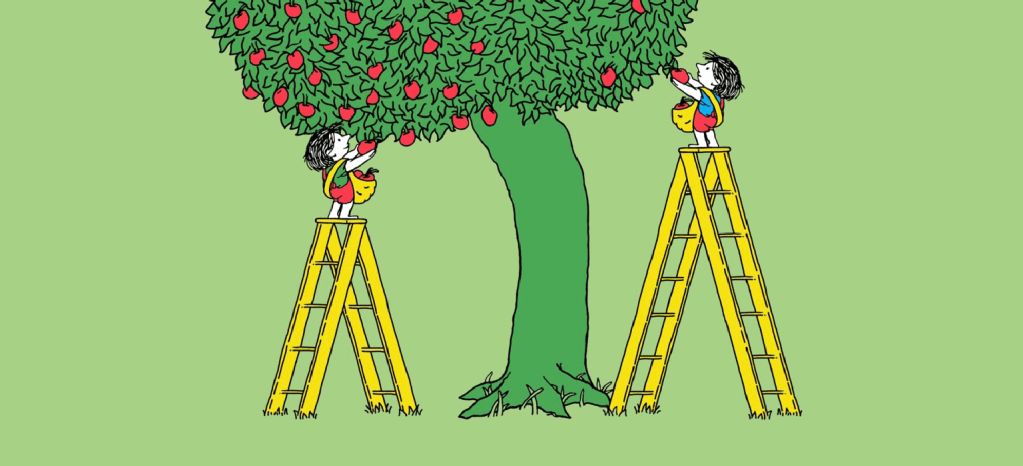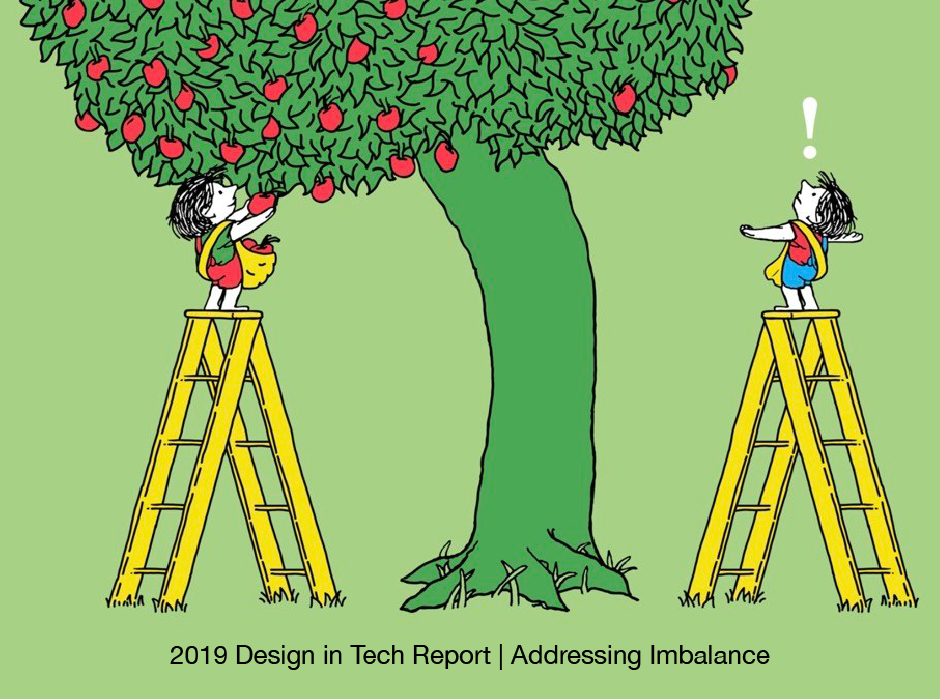Equity vs. Equality: What’s the Difference?

While the terms equity and equality may sound similar, the implementation of one versus the other can lead to dramatically different outcomes for marginalized people.
Equality means each individual or group of people is given the same resources or opportunities. Equity recognizes that each person has different circumstances and allocates the exact resources and opportunities needed to reach an equal outcome.
In the illustration below, two individuals have unequal access to a system — in this case, the tree that provides fruit. With equal support from evenly distributed tools, their access to the fruit still remains unequal. The equitable solution, however, allocates the exact resources that each person needs to access the fruit, leading to positive outcomes for both individuals.
While the tree appears to be a naturally occurring system, it’s critical to remember that social systems aren’t naturally inequitable — they’ve been intentionally designed to reward specific demographics for so long that the system’s outcomes may appear unintentional but are actually rooted discriminatory practices and beliefs.

INEQUALITY

EQUALITY

EQUITY

JUSTICE
Source: “Addressing Imbalance,” by Tony Ruth for the 2019 Design in Tech Report.
Equity is a solution for addressing imbalanced social systems. Justice can take equity one step further by fixing the systems in a way that leads to long-term, sustainable, equitable access for generations to come.
According to the World Health Organization (WHO), equity is defined as “the absence of avoidable or remediable differences among groups of people, whether those groups are defined socially, economically, demographically or geographically.” Therefore, as the WHO notes, health inequities involve more than lack of equal access to needed resources to maintain or improve health outcomes. They also refer to difficulty when it comes to “inequalities that infringe on fairness and human rights norms.”
The U.S. Centers for Disease Control and Prevention (CDC) refers to health equity as “when everyone has the opportunity to be as healthy as possible.” As such, equity is a process and equality is an outcome of that process. Or, as the Race Matters Institute describes, “The route to achieving equity will not be accomplished through treating everyone equally. It will be achieved by treating everyone equitably, or justly according to their circumstances.”
Understanding the difference between health equality and health equity is important to public health to ensure that resources are directed appropriately — as well as supporting the ongoing process of meeting people where they are. Inherent to this process is the promotion of diversity in teams and personnel, public health practice, research methods and other related factors. For these reasons, providing the same type and number of resources to all is not enough. In order to reduce the health disparities gap, the underlying issues and individual needs of underserved and vulnerable populations must be effectively addressed.
The Difference Between Equity and Equality
“The route to achieving equity will not be accomplished through treating everyone equally. It will be achieved by treating everyone justly according to their circumstances.”
—Paula Dressel, Race Matters Institute 1
EXAMPLES OF EQUALITY2
A city cuts the budget for 25 community centers by reducing the operational hours for all centers by the same amount at the same times.
A community meeting, where all members of the community are invited, about a local environmental health concern is held in English though English is not the primary language for 25% of the residents.
Examples of EqualityAll public schools in a community have computer labs with the same number of computers and hours of operation during school hours.
EXAMPLES OF EQUITY2
The city determines which times and how many hours communities actually need to use their community centers and reduces hours for centers that aren’t used as frequently.
Examples of EquityThe community leaders hire translators to attend the meeting or offer an additional meeting held in another language.
Examples of EquityComputer labs in lower income neighborhoods have more computers and printers, as well as longer hours of operation, as some students don’t have access to computers or internet at home.
There are many successful initiatives in communities around the United States where specific steps have been taken to make approaches to health more equitable (PDF, 4.9MB), according to the CDC. Attempts to achieve equity have involved identifying the individualized needs of specific populations and implementing steps to help meet those needs. Below are three examples of public health initiatives.
Project Brotherhood
Project Brotherhood — a clinic for Black men at Woodlawn Health Center in Chicago — was created through the CDC’s Healthy Communities Program. The clinic was formed by a Black physician and a nurse-epidemiologist who were interested in better addressing the health needs of Black men. Partnering with a Black social science researcher, they conducted focus groups with Black men to learn about their experiences with the health care system and met with other Black staff at the clinic. As a result of this research, Project Brotherhood employed a number of specific strategies, including:
- Offering free health care, with optional appointments and evening clinic hours, to make health care more accessible to Black men.
- Providing health seminars and courses specifically for Black men.
- Employing a barber to perform free haircuts after receiving health education training to be a health advocate for Black men whom the clinic staff could not reach.
- Providing fatherhood classes to help Black men become more effectively involved in the lives of their children.
- Building “a culturally competent workforce able to create a safe, respectful, male-friendly environment and to overcome mistrust in Black communities toward the traditional health care system.”
- Organizing physician participation in support group discussions to enhance understanding between providers and patients.
According to the organization, positive outcomes were achieved: “In January 1999, Project Brotherhood averaged four medical visits and eight group participants per week. By September 2005, the average grew to 27 medical visits and 35 group participants per week….” By 2007, Project Brotherhood had provided service to more than 13,000 people since the initiative started and created a health services environment designed specifically for Black men where they would be respected, heard and empowered, thus helping to reduce the health disparities experienced by this population.
Poder es Salud
Poder es Salud (Power for Health) is a partnership involving nonprofits, government organizations, local health care providers and several community- and faith-based groups. This partnership was formed to address social determinants of health and reduce health disparities in Black and Latino communities in Multnomah County, Oregon, by employing an approach to “increase social capital through durable social networks for the purpose of facilitating the achievement of community goals and health outcomes.” This was achieved through three specific strategies:
- Conducting community-based participatory research to support cross-cultural partnerships.
- Implementing popular education, which involves mutual learning and analysis.
- Providing community health workers with specialized training “in leadership, local politics, governance structure, advocacy, community organizing, popular education, and health.”
Program effectiveness was reflected in follow-up surveys that showed “significant improvements in social support, self-rated health and mental health among community members that participated in the interventions with community health workers who use popular education.”
Project BRAVE: Building and Revitalizing an Anti-Violence Environment
Project BRAVE is a school-based intervention that builds on existing relationships among schools, community members, community-based organizations and local researchers. In doing so, Project BRAVE supports preexisting opportunities for students to share their experiences with violence and to take part in community change to reduce it. The program’s effectiveness was evidenced by an increase in school attendance, which is an important social determinant of community health.
Using Equity and Equality in Public Health Practice
Understanding the difference between equity and equality is a key component in the effort to reduce health disparities among vulnerable populations. The good news is that public health officials can take specific steps to help address this confusion in their own communities — including using educational resources such as the CDC’s Defining and Measuring Disparities, Inequities, and Inequalities in the Healthy People Initiative (PDF, 391KB) and group exercises such as those suggested by JustHealthAction (PDF, 637KB), in which teams can work together to differentiate between equity and equality.
Additional Resources about Equity and Equality
- Office of Health Equity, U.S. Department of Health and Human Services
- Health Equity, American Public Health Association
- Equity of Opportunity, U.S. Department of Education
- Health Equity: Why It Matters, and How To Take Action, Robert Wood Johnson Foundation
- Racial Equity Impact Assessment Toolkit, Race Forward
- Equity vs. Equality: 6 Steps Toward Equity, Edutopia
Sources:
1 “Racial Equality or Racial Equity? The Difference it Makes,” Race Matters Institute. 2014. Accessed Oct. 15, 2020. http://viablefuturescenter.org/racemattersinstitute/2014/04/02/racial-equality-or-racial-equity-the-difference-it-makes/
2 “How are Equity and Equality Different?” Just Health Action, 2010. Accessed Oct. 15, 2010. http://justhealthaction.org/wp-content/uploads/2010/05/JHA-Lesson-Plan-3-How-are-equity-and-equality-different-final.pdf
Citation for this content: MPH@GW, the George Washington University online Master of Public Health program


